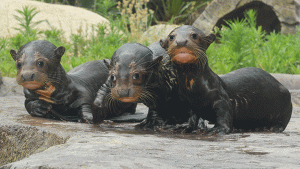The giant otter family at the Los Angeles Zoo recently got a little bigger with the arrival of three new pups, and officials on Wednesday released the first photos and a video of the trio.

The pups, two males and one female, were born on March 28, 2015, according to an L.A. Zoo news release sent Wednesday afternoon.
They joined their 10-month-old juvenile siblings, which were the first to be born at the Rainforest of the Americas habit since its opening at the zoo in April 2014, the release stated.
Zoo officials said the state-of-the-art habitat was specially designed to house a large group of giant otters.
“Historically, there has been a high infant mortality rate for giant otters in captivity,” Jennie Becker, Curator of Mammals at Los Angeles Zoo, explained in the release. “This could be due to a lot of different factors: stress, outside noise, or the female not being confident.”
The habitat is designed to ensure the otters successfully reproduce. It includes a temperature-controlled holding area, multiple next boxes to rest and sleep in, and enough land and water space to give the family ample room to move around and play, according to the zoo.
“This new habitat at the Rainforest of the Americas takes those factors into account and really gives the mother all of the opportunities she needs to reproduce successfully, which she has twice now,” Becker said.
The two litters born at the habit are the first “non-hand reared” giant otter pups that have ever been born at the zoo, the release stated.
“We weren’t really sure what to expect from the parents since the female was hand-reared by Animal Care staff, but we’re happy to see that the family group is doing very well,” Becker said. “The juveniles are very watchful over their new, younger siblings and are helping the parents teach the pups basic skills.”
She added, “This is how it would be done in the wild.”